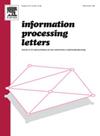The complexity of computing the period and the exponent of a digraph
IF 0.6
4区 计算机科学
Q4 COMPUTER SCIENCE, INFORMATION SYSTEMS
引用次数: 0
Abstract
The period of a strongly connected digraph is the greatest common divisor of the lengths of all its cycles. The period of a digraph is the least common multiple of the periods of its strongly connected components. These notions play an important role in the theory of Markov chains and the analysis of powers of nonnegative matrices. While the time complexity of computing the period is well-understood, little is known about its space complexity. We show that the problem of computing the period of a digraph is NL-complete, even if all its cycles are contained in the same strongly connected component. However, if the digraph is strongly connected, we show that this problem becomes L-complete. For primitive digraphs (that is, strongly connected digraphs of period one), there always exists a number m such that there is a path of length exactly m between every two vertices. We show that computing the smallest such m, called the exponent of a digraph, is NL-complete. The exponent of a primitive digraph is a particular case of the index of convergence of a nonnegative matrix, which we also show to be computable in NL, and thus NL-complete.
计算一个有向图的周期和指数的复杂性
强连通有向图的周期是其所有循环长度的最大公约数。有向图的周期是其强连通分量周期的最小公倍数。这些概念在马尔可夫链理论和非负矩阵幂的分析中起着重要的作用。虽然计算周期的时间复杂性很好理解,但对其空间复杂性知之甚少。我们证明了计算有向图周期的问题是nl完全的,即使它的所有循环都包含在同一个强连接分量中。然而,如果有向图是强连接的,我们证明这个问题是l完全的。对于基本有向图(即周期为1的强连通有向图),总是存在一个数字m,使得每两个顶点之间存在长度恰好为m的路径。我们证明计算最小的这样的m,称为有向图的指数,是nl完全的。原始有向图的指数是非负矩阵收敛指数的一种特殊情况,我们也证明了它在NL中是可计算的,因此是NL完全的。
本文章由计算机程序翻译,如有差异,请以英文原文为准。
求助全文
约1分钟内获得全文
求助全文
来源期刊

Information Processing Letters
工程技术-计算机:信息系统
CiteScore
1.80
自引率
0.00%
发文量
70
审稿时长
7.3 months
期刊介绍:
Information Processing Letters invites submission of original research articles that focus on fundamental aspects of information processing and computing. This naturally includes work in the broadly understood field of theoretical computer science; although papers in all areas of scientific inquiry will be given consideration, provided that they describe research contributions credibly motivated by applications to computing and involve rigorous methodology. High quality experimental papers that address topics of sufficiently broad interest may also be considered.
Since its inception in 1971, Information Processing Letters has served as a forum for timely dissemination of short, concise and focused research contributions. Continuing with this tradition, and to expedite the reviewing process, manuscripts are generally limited in length to nine pages when they appear in print.
 求助内容:
求助内容: 应助结果提醒方式:
应助结果提醒方式:


